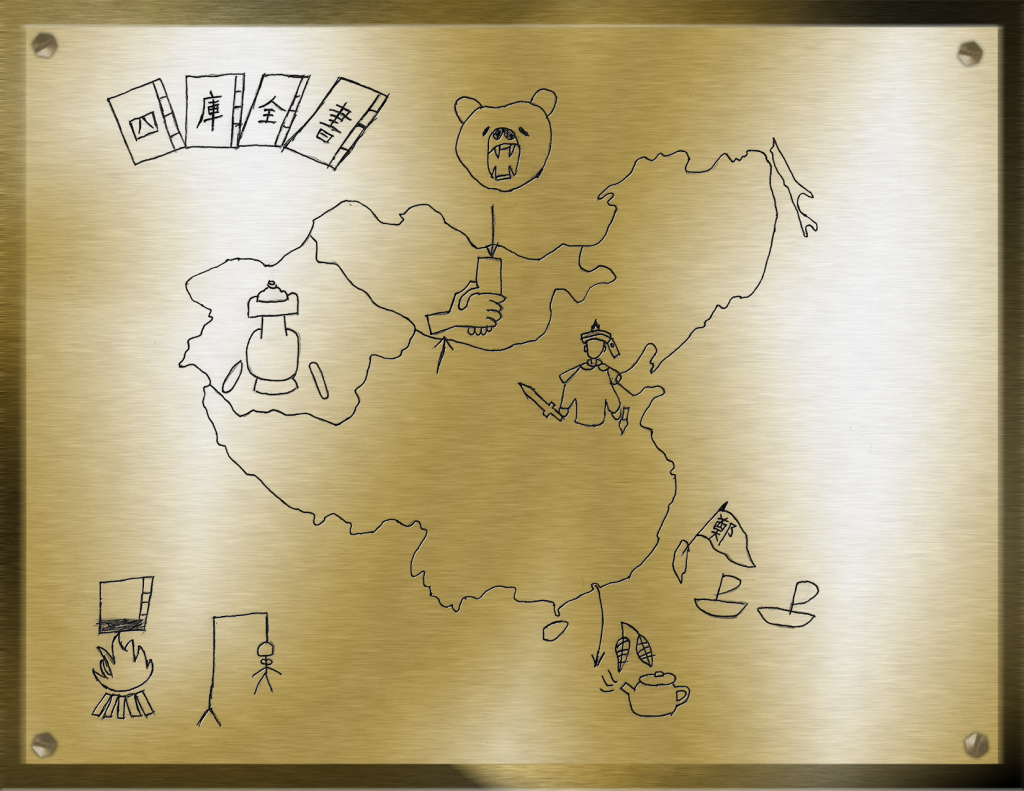
| Time Period | 1650-1800 |
| Geographical Region | China under the rule of the Qing Dynasty |
| List of Symbols |
|
The Qing dynasty was the dynasty closest to modern China. Therefore, it left a lot of effects on the transition from ancient China to modern China, while also producing precious treasure that were passed down till now. What I want to portray in this plaque are the outstanding incidents or existences that best reflect the characteristics of Qing Dynasty and the long effect it had on the development of China.
The first symbol in the middle around the capital of the Qing Dynasty, which is a typical Qing style officer who is holding both a sword and a writing brush. This is the symbol that represents the Office for Military Plans, also known as Junjichu. This was the Qing-created secretary agency that best illustrated the characteristic of Qing’s political status, which was having the least number of officers. This “grand council” not only helped emperors making their decisions, but also took part in coordinating military campaigns.
The second symbol is the tea pot and tea leaves, representing tea exports from Canton at the south of China. This symbol best described the economic activities between Qing Dynasty and the world outside of it. The Canton trade consisted of commercial activities mainly between China and Europe, in which China exported a large amount of goods, one of which was tea, and resulted in getting a huge inflow of silver. This Canton trade was a triumph of Chinese defensive foreign policy and the Qing state’s benign attitude toward trade.
The third symbol in the Tibetan area is the equipment that was used as a way of the Qing government supervising the process of the reincarnation of Dalai Lama. This symbol represents the installation of the garrison that served to supervise the theocratic regime of the Dalai Lama. This is quite important because there was a spread of Lamaism among the Mongols. Therefore, the supervision was one of the main powers that helped the Qing government maintain the Mongols under its control.
The fourth symbol is two hands holding together with one hand from China and the other from a bear head which represents Russia. This symbol shows the peace treaty the two countries back then came to. This peace treaty was another main force that supplemented the control Qing government had over the Mongols. With the Qing and Russian empires generally staying on good terms, negotiating settlements of border difficulties, maintaining a large and peaceful trade, and each refusing to ally with the Mongols against the other, the Qing government managed to easily restrained the Mongols, limiting its power against the Qing government.
The fifth symbol is the “Zheng” flag and warships around Taiwan Island. This symbol refers to the Zheng family in Taiwan. The Zheng family started from doing commercial between the China’s coast close to Fuzhou and Japan, gradually growing into a strong maritime power. It once supported the remaining power of Ming dynasty, but later on diminished into a limited power led by Zheng Chenggong. The Zheng family’s power of resisting Qing government on the land was limited, therefore it mainly fought against Qing army around Taiwan in sea battles. This war between the Zheng family and the Qing government was not important in the military campaign but rather, was seen as a critical reason of Qing restricting its cross-sea contact with outsiders and the limitation in trade.
The last symbol is books coming from all directions to constitute a huge collection that is written into four books (not the Zhu Xi’s four books), while some books got burnt and men got killed. This symbol depicts the process of the creation of The Siku Quanshu (Complete Collection of the Four Treasuries). This project was generated by the Qianlong Emperor to exalt the name of him and his dynasty to later generations. Since the Qianlong always wanted to portray himself as a scholar, he ordered the largest project in Chinese history to collect, preserve, and evaluate old books. (p252) It was thought to be a great achievement, which it definitely was, but there many books got burnt and people got killed because of this project since they were perceived to be bad books and those who kept bad books. This is a milestone of the scholar history of China, but also includes political complexion.
As I wrote, I believe Qing Dynasty had profoundly affected the transition from ancient China to modern China, while leaving great precious for generations after. These six symbols, representing famous and critical events and the legacy of Qing Dynasty, together portray a complex but distinctive picture of China under the rule of Qing Dynasty.
XUFENG MA is an undergraduate international student from Shanghai, China. He is doing a triple major in Business, Japanese and East Asian Studies. He believes precious knowledge can be learned from studying the past, and this idea generates huge passion for him.
